Experimental Study on the Influence of an Artificial Reef on Cross-Shore Morphodynamic Processes of a Wave-Dominated Beach
Abstract
1. Introduction
2. Methodology
2.1. Experimental Design
2.2. Instrumentation and Data Analysis Techniques
2.2.1. Wave Transformation
2.2.2. Wave Skewness and Asymmetry
2.2.3. Undertow Estimation
2.2.4. Velocity and Turbulent Kinetic Energy (TKE)
2.2.5. Sediment Transport
2.2.6. Dimension of the Profile Feature
3. Results
3.1. Regular Wave Tests
3.1.1. Hydrodynamics
3.1.2. Beach Evolution
3.2. Irregular Wave Tests
3.2.1. Hydrodynamics
3.2.2. Beach Evolution
3.3. Cross-Shore Hydrodynamics and Morphodynamics
4. Discussion
4.1. Implications for Beach States
4.2. Scarp Evolution
5. Conclusions
Author Contributions
Funding
Acknowledgments
Conflicts of Interest
References
- Luijendijk, A.; Hagenaars, G.; Ranasinghe, R.; Baart, F.; Donchyts, G.; Aarninkhof, S. The state of the world’s beaches. Sci. Rep. 2018, 8, 6641. [Google Scholar] [CrossRef] [PubMed]
- Van Rijn, L.C. Coastal erosion and control. In Ocean & Coastal Management; Elsevier: New York, NY, USA, 2011; Volume 54, pp. 867–887. [Google Scholar]
- McKenna, J.; Cooper, A.; O’Hagan, A.M. Managing by principle: A critical analysis of the European principles of Integrated Coastal Zone Management (ICZM). Mar. Policy 2008, 32, 941–955. [Google Scholar] [CrossRef]
- Lamberti, A.; Archetti, R.; Kramer, M.; Paphitis, D.; Mosso, C.; Di Risio, M. European experience of low crested structures for coastal management. Coast. Eng. 2005, 52, 841–866. [Google Scholar] [CrossRef]
- Ranasinghe, R.; Turner, I.L. Shoreline response to submerged structures: A review. Coast. Eng. 2006, 53, 65–79. [Google Scholar] [CrossRef]
- Luo, S.; Cai, F.; Liu, H.; Lei, G.; Qi, H.; Su, X. Adaptive measures adopted for risk reduction of coastal erosion in the People’s Republic of China. Ocean Coast. Manag. 2015, 103, 134–145. [Google Scholar] [CrossRef]
- Luo, S.; Liu, Y.; Jin, R.; Zhang, J.; Wei, W. A guide to coastal management: Benefits and lessons learned of beach nourishment practices in China over the past two decades. Ocean Coast. Manag. 2016, 134, 207–215. [Google Scholar] [CrossRef]
- Gu, J.; Ma, Y.; Wang, B.; Sui, J.; Kuang, C.; Liu, J.; Lei, G. Influence of near-shore marine structures in a beach nourishment project on tidal currents in Haitan Bay, facing the Taiwan Strait. J. Hydrodyn. Ser. B 2016, 28, 690–701. [Google Scholar] [CrossRef]
- Everts, C. Impact of Sand Retention Structures on Southern and Central California Beaches, Draft Report 2002; California Coastal Conservancy: Oakland, CA, USA, 2002.
- Karunarathna, H.; Tanimoto, K. Numerical experiments on low-frequency fluctuations on a submerged coastal reef. Coast. Eng. 1995, 26, 271–289. [Google Scholar] [CrossRef]
- Karunarathna, H.; Tanimoto, K. Long-period water surface fluctuations on a horizontal coastal shelf with a steep seaward face. Coast. Eng. 1996, 29, 123–147. [Google Scholar] [CrossRef]
- Lentz, S.J.; Churchill, J.H.; Davis, K.A.; Farrar, J.T. Surface gravity wave transformation across a platform coral reef in the Red Sea. J. Geophys. Res. Oceans 2016, 121, 693–705. [Google Scholar] [CrossRef]
- Masselink, G.; Tuck, M.; McCall, R.; van Dongeren, A.; Ford, M.; Kench, P. Physical and numerical modeling of infragravity wave generation and transformation on coral reef platforms. J. Geophys. Res. Oceans 2019, 124, 1410–1433. [Google Scholar] [CrossRef]
- Sous, D.; Tissier, M.; Rey, V.; Touboul, J.; Bouchette, F.; Devenon, J.; Chevalier, C.; Aucan, J. Wave transformation over a barrier reef. Cont. Shelf Res. 2019, 184, 66–80. [Google Scholar] [CrossRef]
- Ning, Y.; Liu, W.; Zhao, X.; Zhang, Y.; Sun, Z. Study of irregular wave run-up over fringing reefs based on a shock-capturing Boussinesq model. Appl. Ocean Res. 2019, 84, 216–224. [Google Scholar] [CrossRef]
- Yao, Y.; He, W.; Du, R.; Jiang, C. Study on wave-induced setup over fringing reefs in the presence of a reef crest. Appl. Ocean Res. 2017, 66, 164–177. [Google Scholar] [CrossRef]
- Yao, Y.; Zhang, Q.; Chen, S.; Tang, Z. Effects of reef morphology variations on wave processes over fringing reefs. Appl. Ocean Res. 2019, 82, 52–162. [Google Scholar] [CrossRef]
- Costa, M.B.S.F.; Araújo, M.; Araújo, T.C.M.; Siegle, E. Influence of reef geometry on wave attenuation on a Brazilian coral reef. Geomorphology 2016, 253, 318–327. [Google Scholar] [CrossRef]
- Spalding, M.D.; Ruffo, S.; Lacambra, C.; Meliance, I.; Hale, L.Z.; Shepard, C.C.; Beck, M.W. The role of ecosystems in coastal protection: Adapting to climate change and coastal hazards. Ocean Coast. Manag. 2014, 90, 50–57. [Google Scholar] [CrossRef]
- Ferrario, F.; Beck, M.W.; Storlazzi, C.D.; Micheil, F.; Shepard, C.C.; Airoldi, L. The effectiveness of coral reefs for coastal hazard risk reduction and adaptation. Nat. Commun. 2014, 5, 3794. [Google Scholar] [CrossRef]
- Sanderson, P.G.; Eliot, I. Compartmentalisation of beachface sediments along the southwestern coast of Australia. Mar. Geol. 1999, 1, 145–164. [Google Scholar] [CrossRef]
- De Alegria-Arzaburu, A.R.D.; Mariño-Tapia, I.; Enriquez, C.; Silva, R.; González-Leija, M. The role of fringing coral reefs on beach morphodynamics. Geomorphology 2013, 198, 69–83. [Google Scholar] [CrossRef]
- Reguero, B.G.; Beck, M.W.; Agostini, V.N.; Kramer, P.; Hancock, B. Coral reefs for coastal protection: A new methodological approach and engineering case study in Grenada. J. Environ. Manag. 2018, 210, 146–161. [Google Scholar] [CrossRef] [PubMed]
- López, I.; Tinoco, H.; Aragonés, L.; García-Barba, J. The multifunctional artificial reef and its role in the defence of the Mediterranean coast. Sci. Total Environ. 2016, 550, 910–923. [Google Scholar] [CrossRef] [PubMed]
- Lee, M.O.; Otake, S.; Kim, J.K. Transition of artificial reefs (ARs) research and its prospects. Ocean Coast. Manag. 2018, 154, 55–65. [Google Scholar] [CrossRef]
- Folpp, H.R.; Schilling, H.T.; Clark, G.F.; Lowry, M.B.; Maslen, B.; Gregson, M.; Suthers, I.M. Artificial reefs increase fish abundance in habitat-limited estuaries. J. Appl. Ecol. 2020, 57, 1752–1761. [Google Scholar] [CrossRef]
- Kim, D.; Woo, J.; Yoon, H.S.; Na, W.B. Wake lengths and structural responses of Korean general artificial reefs. Ocean Eng. 2014, 92, 83–91. [Google Scholar] [CrossRef]
- Baine, M. Artificial reefs: A review of their design, application, management and performance. Ocean Coast. Manag. 2001, 44, 3–4, 241–259. [Google Scholar] [CrossRef]
- Lima, J.S.; Zalmon, I.R.; Love, M. Overview and trends of ecological and socioeconomic research on artificial reefs. Mar. Environ. Res. 2019, 145, 81–96. [Google Scholar] [CrossRef]
- Jordan, L.K.B.; Gilliam, D.S.; Spieler, R.E. Reef fish assemblage structure affected by small-scale spacing and size variations of artificial patch reefs. J. Exp. Mar. Biol. Ecol. 2005, 326, 170–186. [Google Scholar] [CrossRef]
- Moschella, P.S.; Abbiati, M.; Aberg, P.; Airoldi, L.; Anderson, J.M.; Bacchiocchi, F.; Bulleri, F.; Dinesen, G.E.; Frost, M.; Gacia, E.; et al. Low-crested coastal defence structures as artificial habitats for marine life: Using ecological criteria in design. Coast. Eng. 2005, 52, 1053–1071. [Google Scholar] [CrossRef]
- Piazza, B.P.; Banks, P.D.; Peyre, M.K.L. The Potential for Created Oyster Shell Reefs as a Sustainable Shoreline Protection Strategy in Louisiana. Restor. Ecol. 2005, 13, 8. [Google Scholar] [CrossRef]
- Harris, L.E. Submerged Reef Structures for Beach Erosion Control. In Proceedings of the Coastal Structures 2003; Coastal Structures: Portland, OR, USA, 2003; pp. 1155–1163. [Google Scholar]
- Borsje, B.W.; van Wesenbeeck, B.K.; Dekker, F.; Paalvast, P.; Bouma, T.J.; van Katwijk, M.M.; de Vries, M.B. How ecological engineering can serve in coastal protection. Ecol. Eng. 2011, 37, 113–122. [Google Scholar] [CrossRef]
- Srisuwan, C.; Rattanamanee, P. Modeling of Seadome as artificial reefs for coastal wave attenuation. Ocean Eng. 2015, 103, 198–210. [Google Scholar] [CrossRef]
- Raineault, N.A.; Trembanis, A.C.; Miller, D.C.; Capone, V. Interannual changes in seafloor surficial geology at an artificial reef site on the inner continental shelf. Cont. Shelf Res. 2013, 58, 67–78. [Google Scholar] [CrossRef]
- Duarte Nemes, D.; Criado-Sudau, F.F.; Gallo, M.N. Beach morphodynamic response to a submerged reef. Water 2019, 11, 340. [Google Scholar] [CrossRef]
- Chadwick, A.; Fleming, C.; Reeve, D.E. Coastal Engineering: Processes, Theory and Design Practice; Spon Press: London, UK, 2004. [Google Scholar]
- Nwogu, O.; Demirbilek, Z. Infragravity wave motions and runup over shallow fringing reefs. J. Waterway Port Coast. Ocean Eng. 2010, 136, 295–305. [Google Scholar] [CrossRef]
- Alsina, J.M.; Cáceres, I. Sediment suspension events in the inner surf and swash zone. Measurements in large-scale and high-energy wave conditions. Coast. Eng. 2011, 58, 657–670. [Google Scholar] [CrossRef]
- Pomeroy, A.W.M.; Lowe, R.J.; Van Dongeren, A.R.; Ghisalberti, M.; Bodde, W.; Roelvink, D. Spectral wave-driven sediment transport across a fringing reef. Coast. Eng. 2015, 98, 78–94. [Google Scholar] [CrossRef]
- Baldock, T.E.; Birrien, F.; Atkinson, F.; Shimamoto, T.; Wu, S.; Callaghan, D.P.; Nielsen, P. Morphological hysteresis in the evolution of beach profiles under sequences of wave climates—Part 1: Observations. Coast. Eng. 2017, 128, 92–105. [Google Scholar] [CrossRef]
- Rocha, M.V.L.; Michallet, H.; Silva, P.A. Improving the parameterization of wave nonlinearities—The importance of wave steepness, spectral bandwidth and beach slope. Coast. Eng. 2017, 121, 77–89. [Google Scholar] [CrossRef]
- Kuang, C.; Mao, X.; Gu, J.; Niu, H.; Ma, Y.; Yang, Y.; Qiu, R.; Zhang, J. Morphological processes of two artificial submerged shore-parallel sandbars for beach nourishment in nearshore zone. Ocean Coast. Manag. 2019, 179, 104870. [Google Scholar] [CrossRef]
- Kuang, C.; Pan, Y.; Zhang, Y.; Liu, S.; Yang, Y.; Zhang, J.; Dong, P. Performance evaluation of a beach nourishment project at West Beach in Beidaihe, China. J. Coast. Res. 2011, 27, 769–783. [Google Scholar]
- Pan, Y.; Kuang, C.; Chen, Y.; Yin, S.; Yang, Y.; Yang, Y.; Zhang, J.; Qiu, R.; Zhang, Y. A comparison of the performance of submerged and detached artificial headlands in a beach nourishment project. Ocean Eng. 2018, 159, 295–304. [Google Scholar] [CrossRef]
- Mao, X. Study on Responses of Dynamic Environment on Beach Nourishment in Beidaihe, China; Tongji University: Shanghai, China, 2016. [Google Scholar]
- Grasso, F.; Michallet, H.; Barthélemy, E. Sediment transport associated with morphological beach changes forced by irregular asymmetric, skewed waves. J. Geophys. Res. Oceans 2011, 116, C03020. [Google Scholar] [CrossRef]
- Berni, C.; Barthélemy, E.; Michallet, H. Surf zone cross-shore boundary layer velocity asymmetry and skewness: An experimental study on a mobile bed. J. Geophys. Res. Oceans 2013, 118, 2188–2200. [Google Scholar] [CrossRef]
- Soulsby, R. Dynamics of Marine Sands: A Manual for Practical Applications; Thomas Telford Publishing: London, UK, 1997. [Google Scholar]
- Dean, R.; Dalrymple, R. Coastal Processes with Engineering Applications; Cambridge University Press: Cambridge, UK, 2002; p. 487. [Google Scholar]
- Van Rijn, L.C. Principles of Sediment Transport in Rivers, Estuaries and Coastal Seas; Aqua Publications: Amsterdam, The Netherlands, 1993. [Google Scholar]
- Ma, Y.; Kuang, C.; Han, X.; Dong, B. Wave Attenuation Mechanism of the Artificial Reef in Beidaihe, China. In Proceedings of the 28th International Ocean and Polar Engineering Conference, Sapporo, Japan, 10–15 June 2018. [Google Scholar]
- Ma, Y.; Kuang, C.; Han, X.; Zhu, L. Experimental investigation on Regular Wave Process through an Artificial Reef. In Proceedings of the 12th ISOPE Pacific/Asia Offshore Mechanics Symposium, Jeju Island, Korea, 14–17 October 2018. [Google Scholar]
- Herbers, T.H.C.; Elgar, S.; Guza, R.T.; O’Reilly, W.C. Infragravity-frequency (0.005–0.05 Hz) motions of the shelf. II: Free waves. J. Phys. Oceanogr. 1995, 25, 1063–1080. [Google Scholar] [CrossRef]
- De Bakker, A.T.M.; Tissier, M.E.S.; Ruessink, B.G. Shoreline dissipation of infragravity waves. Cont. Shelf Res. 2014, 72, 73–82. [Google Scholar] [CrossRef]
- Rijnsdrop, D.; Smit, P.; Zijlema, M. Non-hydrostatic modeling of infragravity waves under laboratory conditions. Coast. Eng. 2014, 85, 30–42. [Google Scholar] [CrossRef]
- Elgar, S.; Gallagher, E.L.; Guza, R.T. Nearshore sandbar migration. J. Geophys. Res. 2001, 106, 11623–11627. [Google Scholar] [CrossRef]
- Watanabe, A.; Sato, S. A sheet-flow transport rate formula for asymmetric, forward-leaning waves and currents. In Proceedings of the 29th International Conference on Coastal Engineering, Lisbon, Portugal, 19–24 September 2004; Volume 2, pp. 1703–1714. [Google Scholar]
- Michallet, H.; Cienfuegos, R.; Barthélemy, E.; Grasso, F. Kinematics of waves propagating and breaking on a barred beach. Eur. J. Mech. B/Fluids 2011, 30, 624–634. [Google Scholar] [CrossRef]
- Nielsen, P.; Callaghan, D.P. Shear stress and sediment transport calculations for sheet flow under waves. Coast. Eng. 2003, 47, 347–354. [Google Scholar] [CrossRef]
- Dally, W.R.; Brown, C.A. A modelling investigation of the breaking wave roller with application to cross-shore currents. J. Geophys. Res. 1995, 110, 24873–24883. [Google Scholar] [CrossRef]
- Mori, N.; Suzuki, T.; Kakuno, S. Noise of Acoustic Doppler Velocimeter data in bubbly flows. J. Eng. Mech. 2007, 133, 122–125. [Google Scholar] [CrossRef]
- Goring, D.G.; Nikora, V.I. Despiking acoustic Doppler velocimeter data. J. Hydraul. Eng. 2002, 128, 117–126. [Google Scholar] [CrossRef]
- Ting, F.C.K. Wave and Turbulence Characteristics in Narrow-band Irregular Breaking Waves. In Proceedings of the 4th International Symposium on Ocean Wave Measurement and Analysis, San Francisco, CA, USA, 2–6 September 2001; pp. 1052–1061. [Google Scholar]
- De Schipper, M.A.; Darnall, J.; De Vries, S.; Reniers, A.J.H.M. Beach scarp evolution and prediction. In Proceedings of the Coastal Symposium, Kohala Coast, HI, USA, 4–8 January 2017; pp. 791–800. [Google Scholar]
- Van Bemmelen, C.W.T. Beach Scarp Morphodynamics: Formation, Migration and Destruction. Master’s Thesis, Delft University of Technology, National University of Singapore, Singapore, 2018. [Google Scholar]
- Alegria-Arzaburu, A.R.D.; Mariño-Tapia, I.; Silva, R.; Pedrozo-Acuña, A. Post-nourishment beach scarp morphodynamics. In Proceedings of the 12th International Coastal Symposium, Plymouth, UK, 9–12 April 2013; pp. 576–581. [Google Scholar]
- Eichentopf, S.; Cáceres, I.; Alsina, J.M. Breaker bar morphodynamics under erosive and accretive wave conditions in large-scale experiments. Coast. Eng. 2018, 138, 36–48. [Google Scholar] [CrossRef]
- Elfrink, B.; Hanes, D.M.; Ruessink, B.G. Parameterization and simulation of near bed orbital velocities under irregular waves in shallow water. Coast. Eng. 2006, 53, 915–927. [Google Scholar] [CrossRef]
- Ruessink, B.G.; Ramaekers, G.; Van Rijn, L.C. On the parameterization of the free-stream non-linear wave orbital motion in nearshore morphodynamic models. Coast. Eng. 2012, 65, 56–63. [Google Scholar] [CrossRef]
- Dong, G.; Chen, H.; Ma, Y. Parameterization of nonlinear shallow water waves over sloping bottoms. Coast. Eng. 2014, 94, 23–32. [Google Scholar] [CrossRef]
- Wright, L.D.; Short, A.D. Morphodynamic variability of surf zones and beaches-a synthesis. Mar. Geol. 1984, 56, 93–118. [Google Scholar] [CrossRef]
- Masselink, G.; Pattiaratchi, C.B. Seasonal changes in beach morphology along the sheltered coastline of Perth, Western Australia. Mar. Geol. 2001, 172, 243–263. [Google Scholar] [CrossRef]
- Wright, L.D.; Short, A.D. Short-term changes in the morphodynamic states of beaches and surf zones: An empirical predictive model. Mar. Geol. 1985, 62, 339–364. [Google Scholar] [CrossRef]
- Guza, R.T.; Inman, D.L. Edge waves and beach cusps. J. Geophys. Res. 1975, 80, 2997–3012. [Google Scholar] [CrossRef]
- Anthony, E.J. Sediment-Wave parametric characteristic of beaches. J. Coast. Res. 1998, 14, 347–352. [Google Scholar]
- Jackson, D.W.T.; Cooper, J.A.G.; del Rio, L. Geological control of beach morphodynamic state. Mar. Geol. 2005, 216, 297–314. [Google Scholar] [CrossRef]
- Le Mehaute, B.; Koh, R.C.Y. On the breaking of waves arriving at an angle to the shore. J. Hydraul. Res. 1967, 5, 67–80. [Google Scholar] [CrossRef]
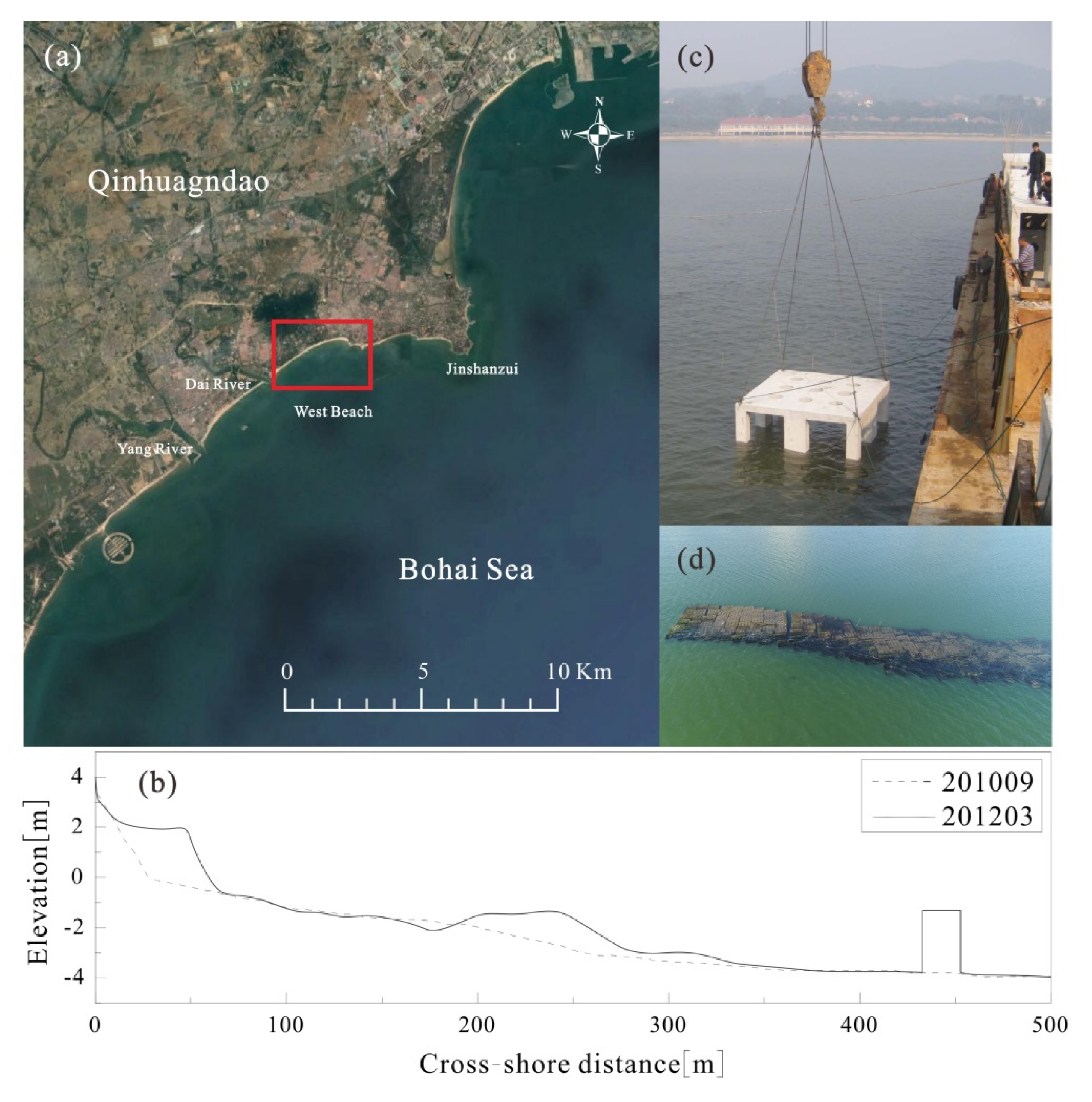
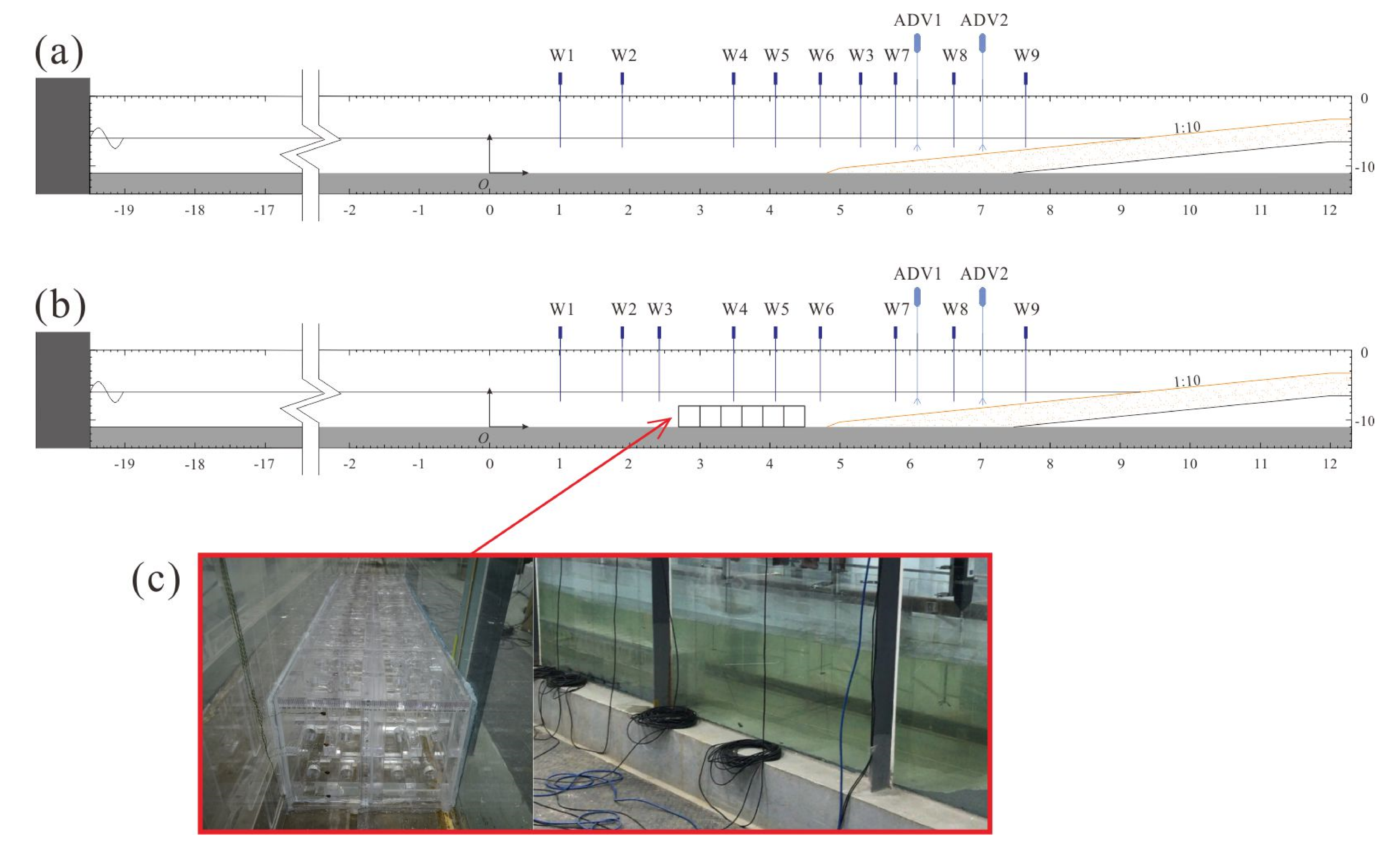
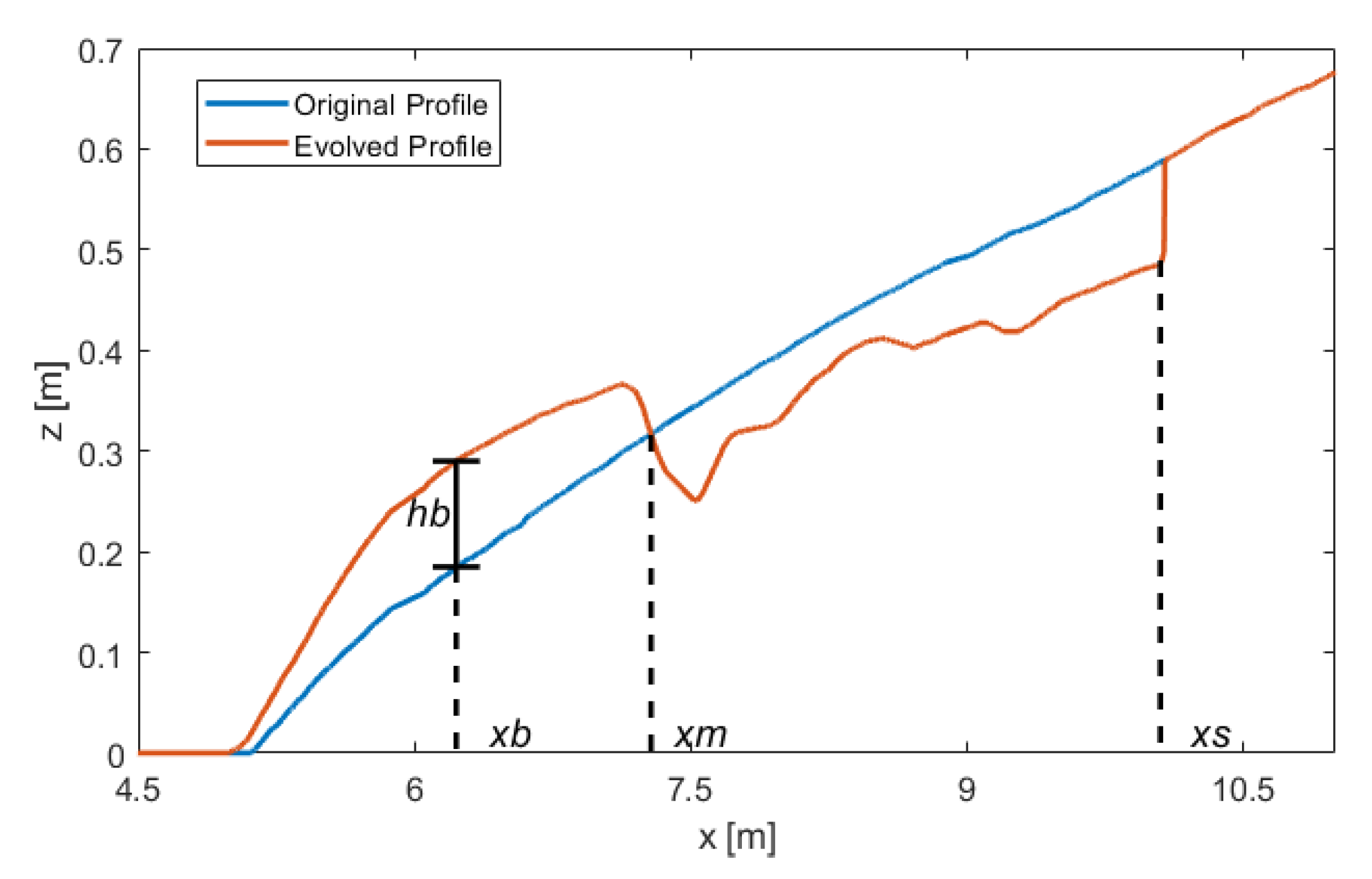

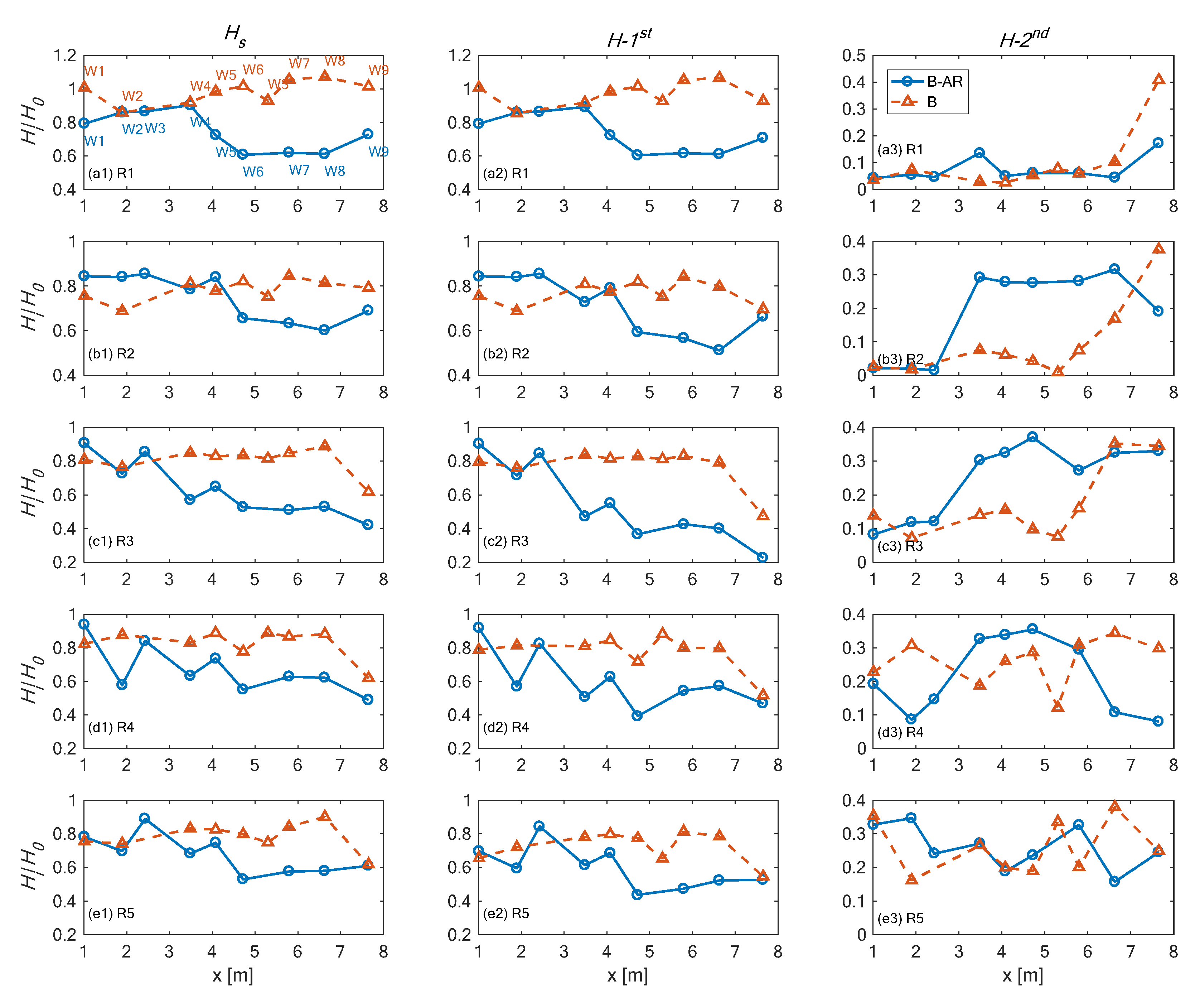
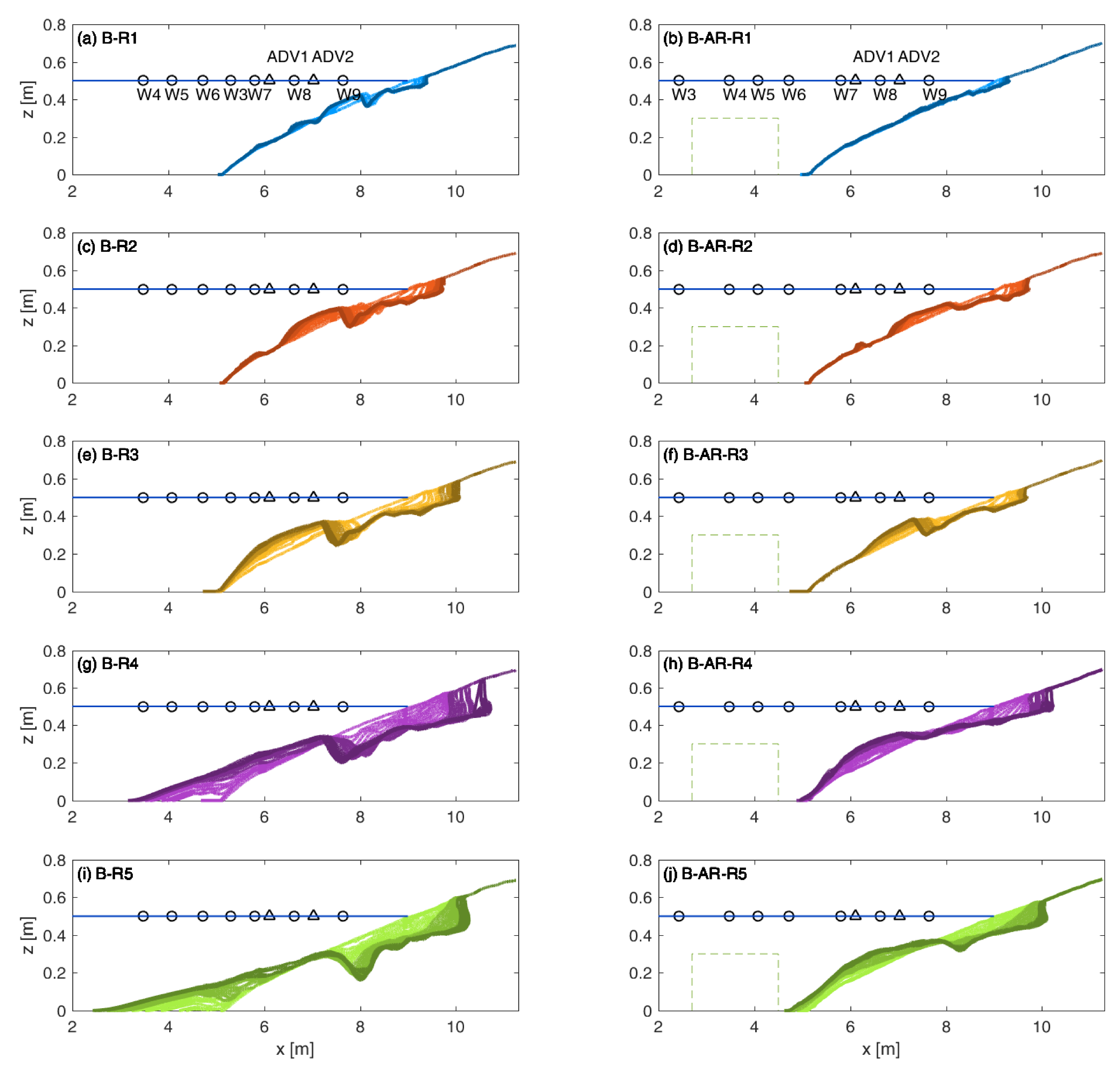
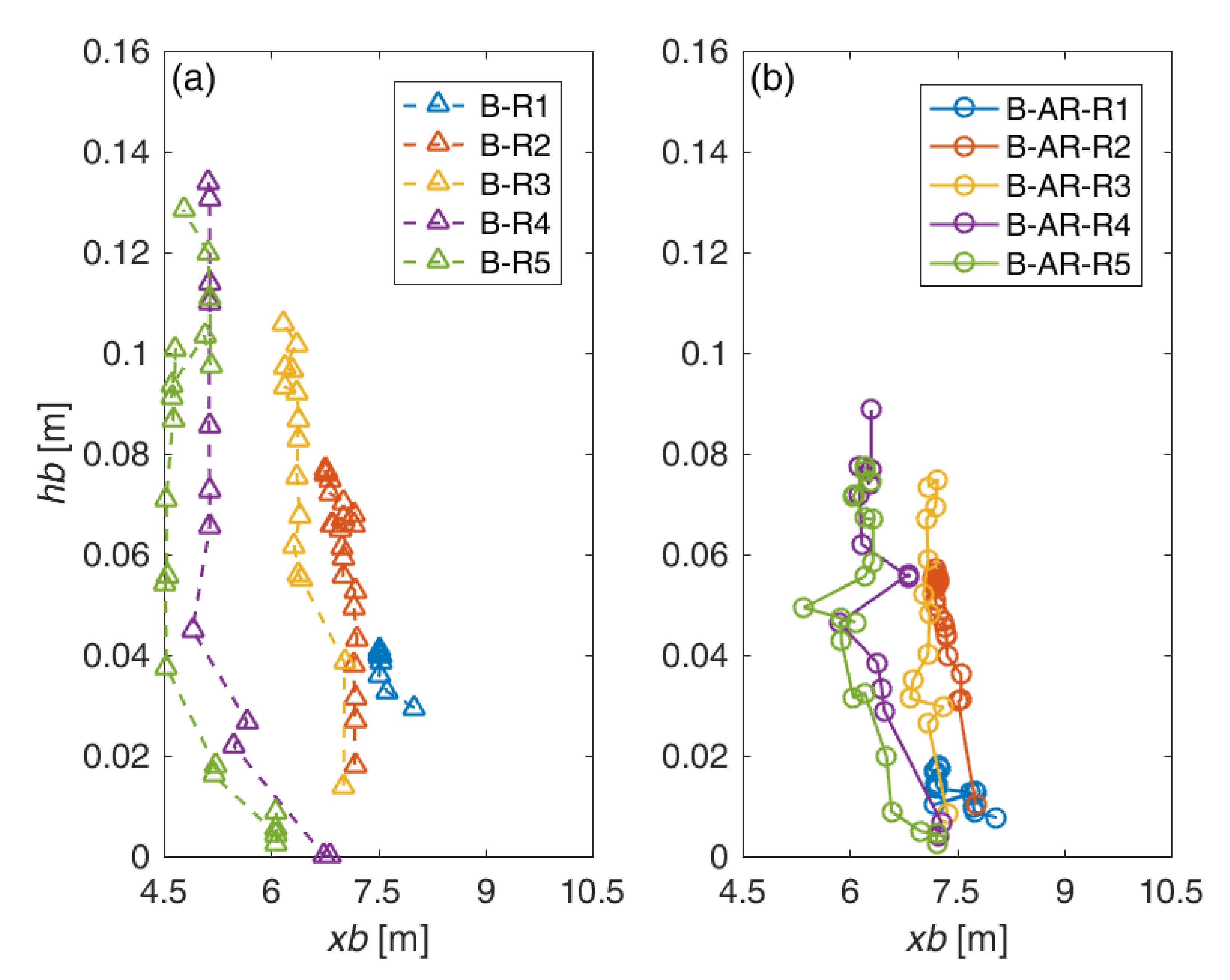
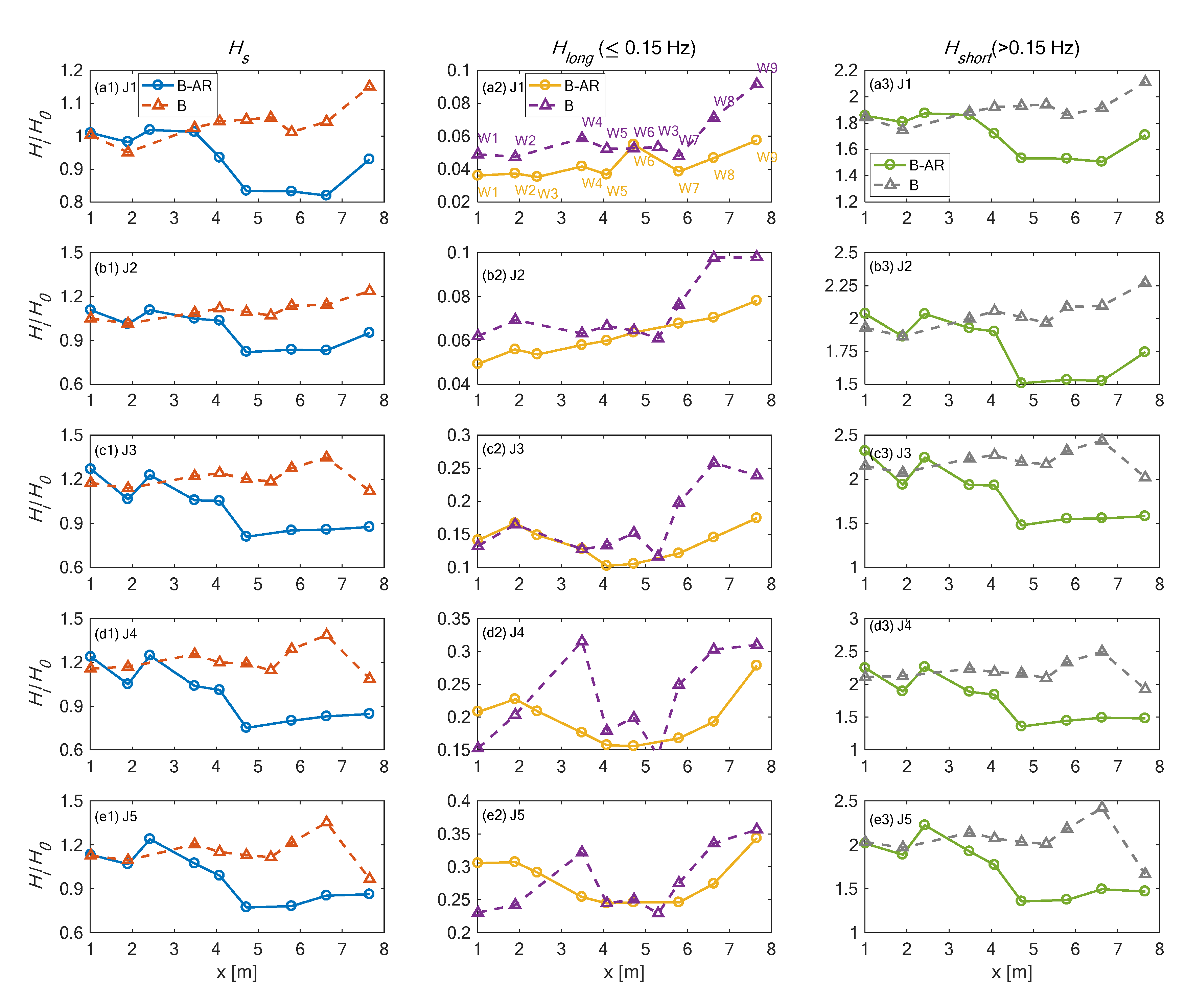
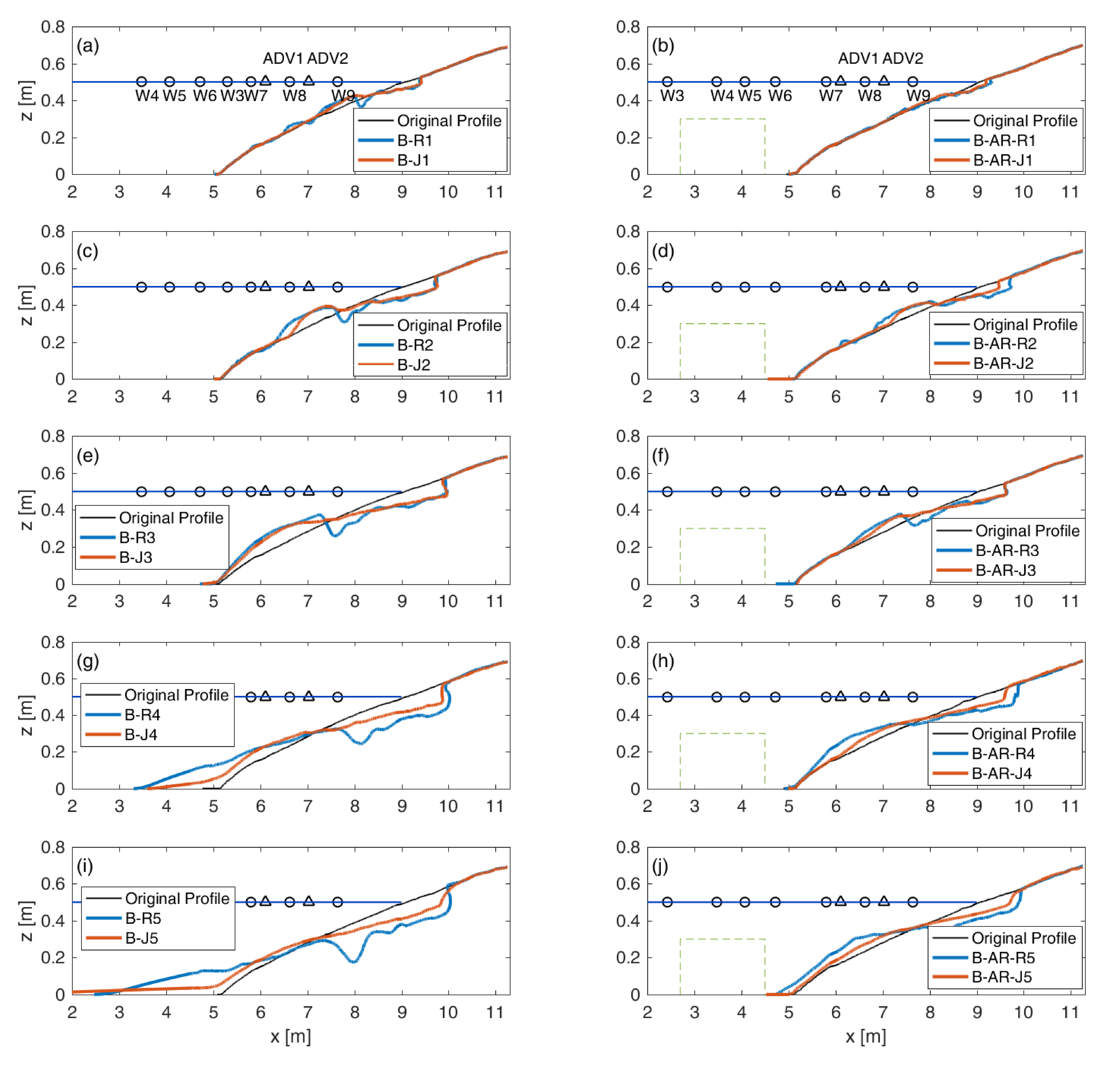
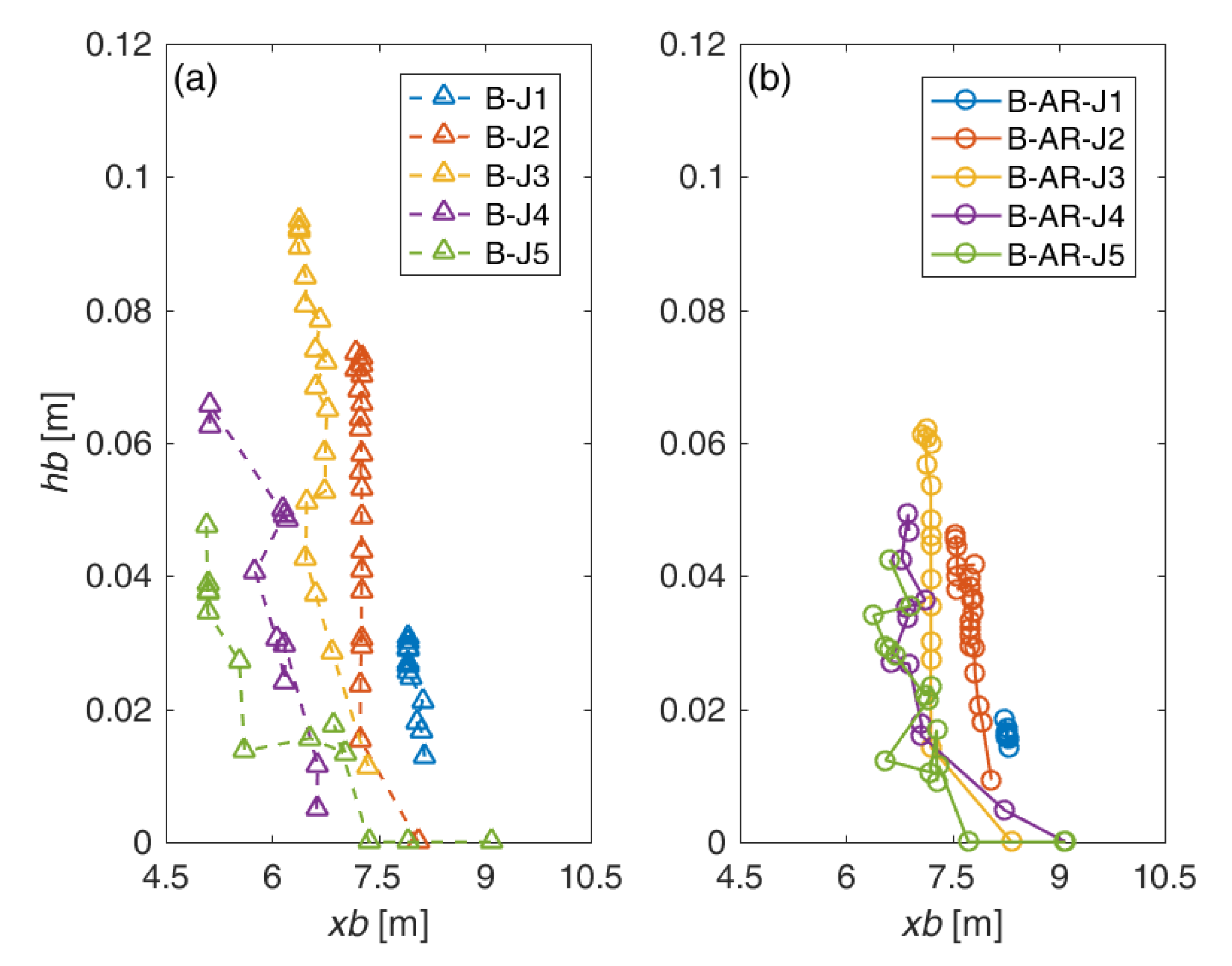
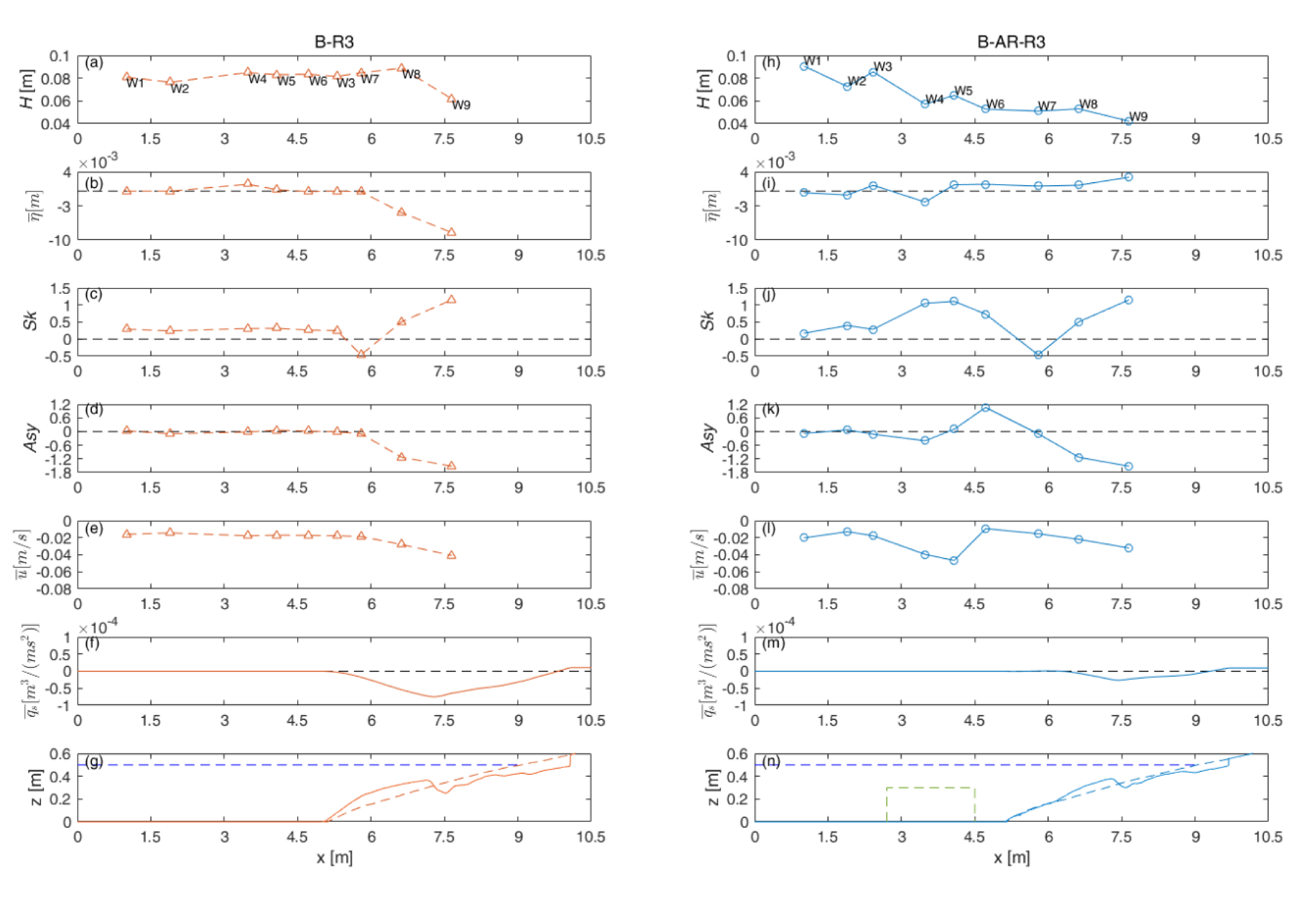

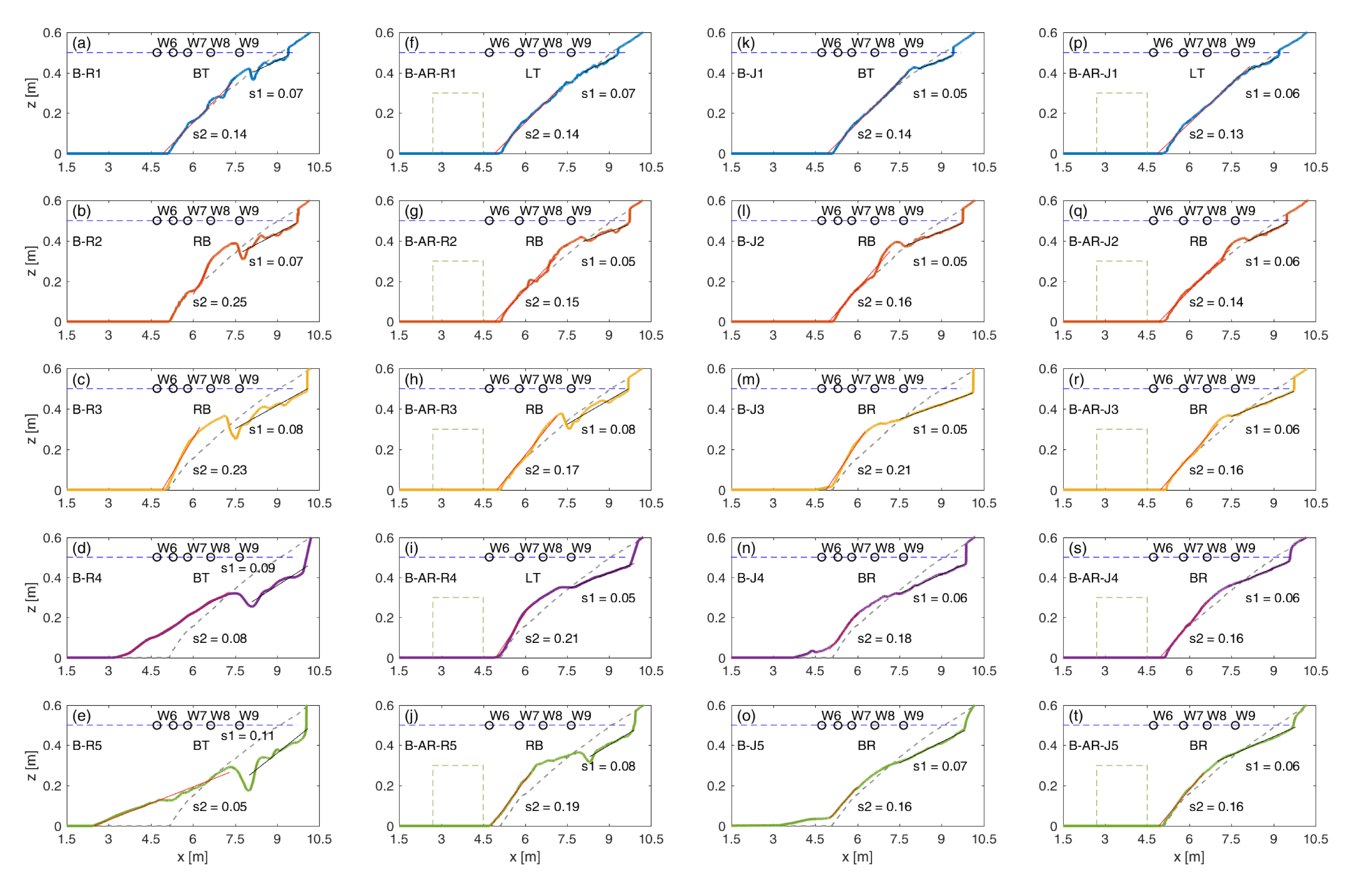

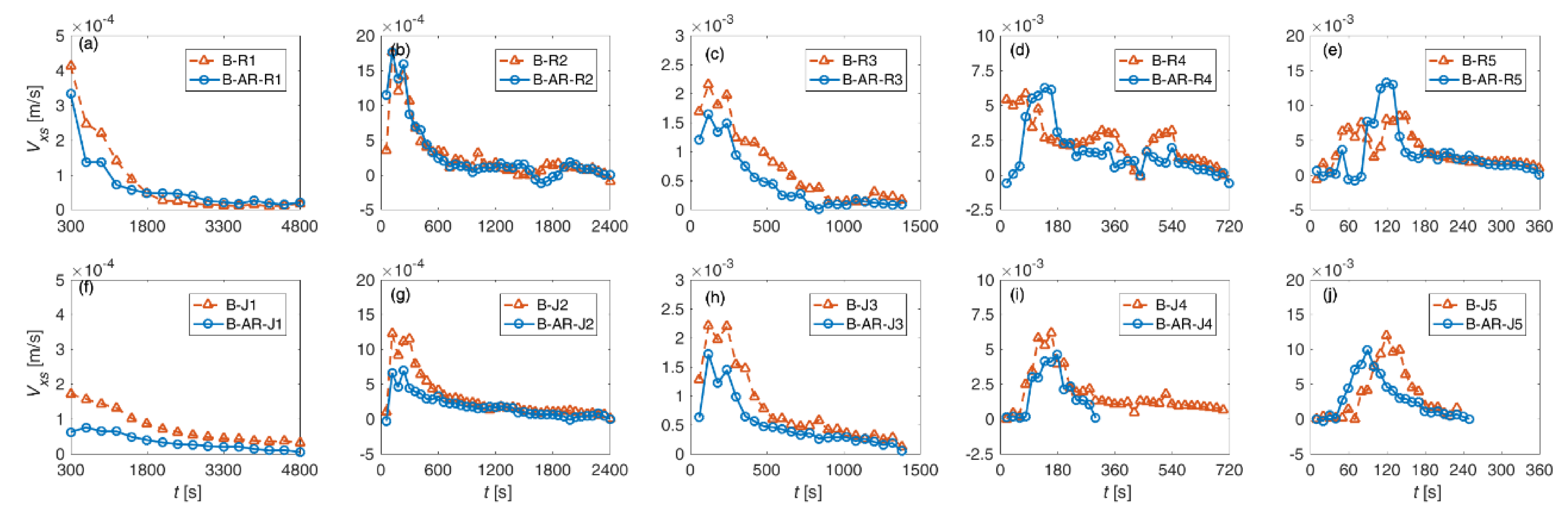
| Test Name | H (m) | T (s) | Duration (min) | Test Name | Hs (m) | Tp (s) | Duration (min) |
|---|---|---|---|---|---|---|---|
| B-R1 | 0.04 | 1.20 | 87 | B-J1 | 0.04 | 1.14 | 87 |
| B-R2 | 0.07 | 1.44 | 44 | B-J2 | 0.07 | 1.38 | 44 |
| B-R3 | 0.10 | 1.57 | 22 | B-J3 | 0.10 | 1.68 | 22 |
| B-R4 | 0.13 | 1.77 | 11 | B-J4 | 0.13 | 1.74 | 11 |
| B-R5 | 0.16 | 2.06 | 5.5 | B-J5 | 0.16 | 2.37 | 2.6 |
| B-AR-R1 | 0.04 | 1.20 | 87 | B-AR-J1 | 0.04 | 1.14 | 87 |
| B-AR-R2 | 0.07 | 1.44 | 44 | B-AR-J2 | 0.07 | 1.38 | 44 |
| B-AR-R3 | 0.10 | 1.57 | 22 | B-AR-J3 | 0.10 | 1.68 | 22 |
| B-AR-R4 | 0.13 | 1.77 | 11 | B-AR-J4 | 0.13 | 1.74 | 4.2 |
| B-AR-R5 | 0.16 | 2.06 | 5.5 | B-AR-J5 | 0.16 | 2.37 | 2.6 |
| Variables | ADV1 | ADV2 | |||||||
|---|---|---|---|---|---|---|---|---|---|
| Test Name | Depth (cm) | Mean-V (cm/s) | Mean-W (cm/s) | TKE (cm2/s2) | Dpeth (cm) | Mean-V (cm/s) | Mean-W (cm/s) | TKE (cm2/s2) | |
| B-R1 | 13.5 | −1.50 | 0.05 | 643 | 8.5 | −0.64 | −0.14 | 343 | |
| B-AR-R1 | 13.5 | −0.37 | 0.05 | 225 | 8.5 | −0.29 | −0.14 | 101 | |
| B-R2 | 13.5 | −4.74 | −0.10 | 1999 | 8.5 | −1.81 | −0.26 | 754 | |
| B-AR-R2 | 13.5 | −1.61 | −0.10 | 943 | 9.0 | −0.87 | −0.26 | 407 | |
| B-R3 | 13.5 | −4.14 | −1.11 | 1895 | 9.0 | −2.00 | −0.71 | 722 | |
| B-AR-R3 | 13.5 | −4.14 | −1.11 | 1362 | 9.0 | −2.00 | −0.71 | 945 | |
| B-R4 | 13.5 | −7.29 | −2.15 | 6126 | 9.0 | −8.55 | −1.13 | 3184 | |
| B-AR-R4 | 13.5 | −6.14 | −2.15 | 1897 | 9.0 | −7.41 | −1.13 | 1194 | |
| B-R5 | 13.5 | −14.39 | −1.36 | 66,498 | 9.0 | −7.90 | −0.88 | 6929 | |
| B-AR-R5 | 13.5 | −4.86 | −1.36 | 68,845 | 9.0 | −8.97 | −0.88 | 1648 | |
| Test Name | xm (m) | Vd (m3/m) | Ve (m3/m) | Test Name | xm (m) | Vd (m3/m) | Ve (m3/m) | Δxm (m) | ΔVd (m3/m) | ΔVe (m3/m) | p (%) |
|---|---|---|---|---|---|---|---|---|---|---|---|
| B-R1 | 8.055 | 0.039 | −0.033 | B-AR-R1 | 8.505 | 0.019 | −0.019 | 0.450 | −0.021 | 0.014 | 42 |
| B-R2 | 7.640 | 0.080 | −0.107 | B-AR-R2 | 8.175 | 0.063 | −0.064 | 0.535 | −0.018 | 0.043 | 40 |
| B-R3 | 7.285 | 0.172 | −0.196 | B-AR-R3 | 7.440 | 0.066 | −0.089 | 0.155 | −0.107 | 0.107 | 55 |
| B-R4 | 7.290 | 0.257 | −0.318 | B-AR-R4 | 7.620 | 0.119 | −0.133 | 0.330 | −0.138 | 0.185 | 58 |
| B-R5 | 6.785 | 0.274 | −0.343 | B-AR-R5 | 7.645 | 0.152 | −0.167 | 0.860 | −0.122 | 0.177 | 52 |
| Variables | ADV1 | ADV2 | |||||||
|---|---|---|---|---|---|---|---|---|---|
| Test Name | Depth (cm) | Mean-V (cm/s) | Mean-W (cm/s) | Depth (cm) | Mean-V (cm/s) | Mean-V (cm/s) | Depth (cm) | Mean-V (cm/s) | |
| B-J1 | 13.5 | −0.27 | −0.01 | 171 | 9.0 | −0.47 | −0.08 | 64 | |
| B-AR-J1 | 13.5 | −0.08 | −0.01 | 105 | 9.0 | −0.21 | −0.08 | 40 | |
| B-J2 | 13.5 | −1.95 | −0.46 | 948 | 9.0 | −1.25 | −0.43 | 350 | |
| B-AR-J2 | 13.5 | −0.29 | −0.46 | 427 | 9.0 | −0.00 | −0.43 | 169 | |
| B-J3 | 13.5 | −2.95 | 1.48 | 45,581 | 9.0 | −5.42 | −1.48 | 1156 | |
| B-AR-J3 | 13.5 | −2.02 | 1.48 | 29,650 | 9.0 | −1.79 | −1.48 | 406 | |
| B-J4 | 13.5 | −3.29 | 1.15 | 105,110 | 9.0 | −9.16 | −1.67 | 2365 | |
| B-AR-J4 | 13.5 | −3.05 | 1.15 | 77,640 | 9.0 | −2.79 | −1.67 | 638 | |
| B-J5 | 13.5 | −0.95 | 2.49 | 10,5270 | 9.0 | −6.38 | −1.17 | 4920 | |
| B-AR-J5 | 13.5 | −1.65 | 2.49 | 87,411 | 9.0 | −3.55 | −1.17 | 1479 | |
| Test Name | xm (m) | Vd (m3/m) | Ve (m3/m) | Test Name | xm (m) | Vd (m3/m) | Ve (m3/m) | Δxm (m) | ΔVd (m3/m) | ΔVe (m3/m) | P (%) |
|---|---|---|---|---|---|---|---|---|---|---|---|
| B-J1 | 8.215 | 0.027 | −0.029 | B-AR-J1 | 8.420 | 0.015 | −0.014 | 0.205 | −0.012 | 0.015 | 52 |
| B-J2 | 7.730 | 0.055 | −0.079 | B-AR-J2 | 8.365 | 0.040 | −0.033 | 0.635 | −0.015 | 0.047 | 59 |
| B-J3 | 7.535 | 0.141 | −0.156 | B-AR-J3 | 7.845 | 0.053 | −0.066 | 0.310 | −0.088 | 0.091 | 58 |
| B-J4 | 7.335 | 0.129 | −0.148 | B-AR-J4 | 7.940 | 0.061 | −0.061 | 0.605 | −0.068 | 0.086 | 58 |
| B-J5 | 7.240 | 0.112 | −0.165 | B-AR-J5 | 7.895 | 0.065 | −0.076 | 0.655 | −0.048 | 0.088 | 53 |
| Waves | R1 | R2 | R3 | R4 | R5 | J1 | J2 | J3 | J4 | J5 | |
|---|---|---|---|---|---|---|---|---|---|---|---|
| Profile Type | |||||||||||
| B | 8.1 | 7.7 | 9.1 | 9.5 | 8.2 | 8.5 | 10.1 | 12.3 | 12.1 | 10.5 | |
| B-AR | 5.6 | 6.7 | 6.5 | 6.7 | 5.8 | 7.1 | 8.0 | 8.9 | 7.9 | 7.8 | |
| Parameter | a (m/s) | b (s) | P1 (m) | P2 (m) | |
|---|---|---|---|---|---|
| Test Name | |||||
| B-R1 | 0.00054 | 696 | 0.374 | 9.39 | |
| B-AR-R1 | 0.00042 | 678 | 0.284 | 9.29 | |
| B-R2 | 0.00094 | 604 | 0.568 | 9.73 | |
| B-AR-R2 | 0.00082 | 591 | 0.482 | 9.73 | |
| B-R3 | 0.00455 | 265 | 1.208 | 10.02 | |
| B-AR-R3 | 0.00409 | 196 | 0.801 | 9.65 | |
| B-J1 | 0.00024 | 1701 | 0.403 | 9.43 | |
| B-AR-J1 | 0.00013 | 1410 | 0.188 | 9.20 | |
| B-J2 | 0.00096 | 691 | 0.662 | 9.74 | |
| B-AR-J2 | 0.00079 | 611 | 0.484 | 9.48 | |
| B-J3 | 0.00369 | 341 | 1.258 | 10.10 | |
| B-AR-J3 | 0.00262 | 310 | 0.811 | 9.71 | |
| Factors | H | L | H/L | ||||
|---|---|---|---|---|---|---|---|
| Cases | |||||||
| B-P1 | 0.9889 (0.03) | 0.4935 (0.67) | 0.9204 (0.26) | 0.9848 (0.11) | 0.9957 (0.06) | −0.9903 (0.09) | |
| B-AR-P1 | 0.9494 (0.20) | 0.9039 (0.28) | 0.9788 (0.13) | 0.8828 (0.31) | 0.9750 (0.14) | −0.8754 (0.32) | |
| B-P2 | 0.9915 (0.08) | 0.6396 (0.56) | 0.9751 (0.14) | 0.9385 (0.22) | 0.9394 (0.05) | −0.9976 (0.20) | |
| B-AR-P2 | 0.9714 (0.15) | 0.9351 (0.23) | 0.9920 (0.08) | 0.9173 (0.26) | 0.9896 (0.09) | −0.9110 (0.27) | |
| B-b | −0.9006 (0.29) | −0.8486 (0.35) | −0.9954 (0.06) | −0.7826 (0.43) | −0.9192 (0.26) | 0.8040 (0.41) | |
| B-AR-b | −0.9994 (0.02) | −0.9878 (0.10) | −0.9969 (0.05) | −0.9793 (0.13) | −0.9981 (0.04) | 0.9760 (0.14) | |
| Factors | Hs | Hlong | Hshort | Ls | Hs/Ls | ||||
|---|---|---|---|---|---|---|---|---|---|
| Cases | |||||||||
| B-P1 | 0.9873 (0.10) | 0.9969 (0.05) | 0.9869 (0.10) | −0.8537 (0.35) | 0.8998 (0.29) | 0.9930 (0.08) | 0.9875 (0.10) | −0.9626 (0.17) | |
| B-AR-P1 | 0.9994 (0.02) | 0.9736 (0.15) | 0.9992 (0.03) | 0.8773 (0.32) | 0.9674 (0.16) | 0.9999 (0.01) | 0.9995 (0.02) | −0.9950 (0.06) | |
| B-P2 | 0.9998 (0.01) | 0.9671 (0.16) | 0.9999 (0.01) | −0.7482 (0.46) | 0.9628 (0.17) | 0.9982 (0.04) | 0.9998 (0.01) | −0.9954 (0.06) | |
| B-AR-P2 | 0.9990 (0.03) | 0.9524 (0.20) | 0.9992 (0.02) | 0.8363 (0.37) | 0.9845 (0.11) | 0.9957 (0.06) | 0.9988 (0.03) | −0.9998 (0.01) | |
| B-b | −0.9435 (0.22) | −0.8384 (0.37) | −0.9443 (0.21) | 0.5021 (0.67) | −0.9990 (0.03) | −0.9292 (0.24) | −0.9432 (0.22) | 0.9753 (0.14) | |
| B-AR-b | −0.9691 (0.16) | −0.8701 (0.33) | −0.9702 (0.16) | −0.7068 (0.50) | −0.9996 (0.02) | −0.9557 (0.19) | −0.9680 (0.16) | 0.9828 (0.12) | |
Publisher’s Note: MDPI stays neutral with regard to jurisdictional claims in published maps and institutional affiliations. |
© 2020 by the authors. Licensee MDPI, Basel, Switzerland. This article is an open access article distributed under the terms and conditions of the Creative Commons Attribution (CC BY) license (http://creativecommons.org/licenses/by/4.0/).
Share and Cite
Ma, Y.; Kuang, C.; Han, X.; Niu, H.; Zheng, Y.; Shen, C. Experimental Study on the Influence of an Artificial Reef on Cross-Shore Morphodynamic Processes of a Wave-Dominated Beach. Water 2020, 12, 2947. https://doi.org/10.3390/w12102947
Ma Y, Kuang C, Han X, Niu H, Zheng Y, Shen C. Experimental Study on the Influence of an Artificial Reef on Cross-Shore Morphodynamic Processes of a Wave-Dominated Beach. Water. 2020; 12(10):2947. https://doi.org/10.3390/w12102947
Chicago/Turabian StyleMa, Yue, Cuiping Kuang, Xuejian Han, Haibo Niu, Yuhua Zheng, and Chao Shen. 2020. "Experimental Study on the Influence of an Artificial Reef on Cross-Shore Morphodynamic Processes of a Wave-Dominated Beach" Water 12, no. 10: 2947. https://doi.org/10.3390/w12102947
APA StyleMa, Y., Kuang, C., Han, X., Niu, H., Zheng, Y., & Shen, C. (2020). Experimental Study on the Influence of an Artificial Reef on Cross-Shore Morphodynamic Processes of a Wave-Dominated Beach. Water, 12(10), 2947. https://doi.org/10.3390/w12102947






